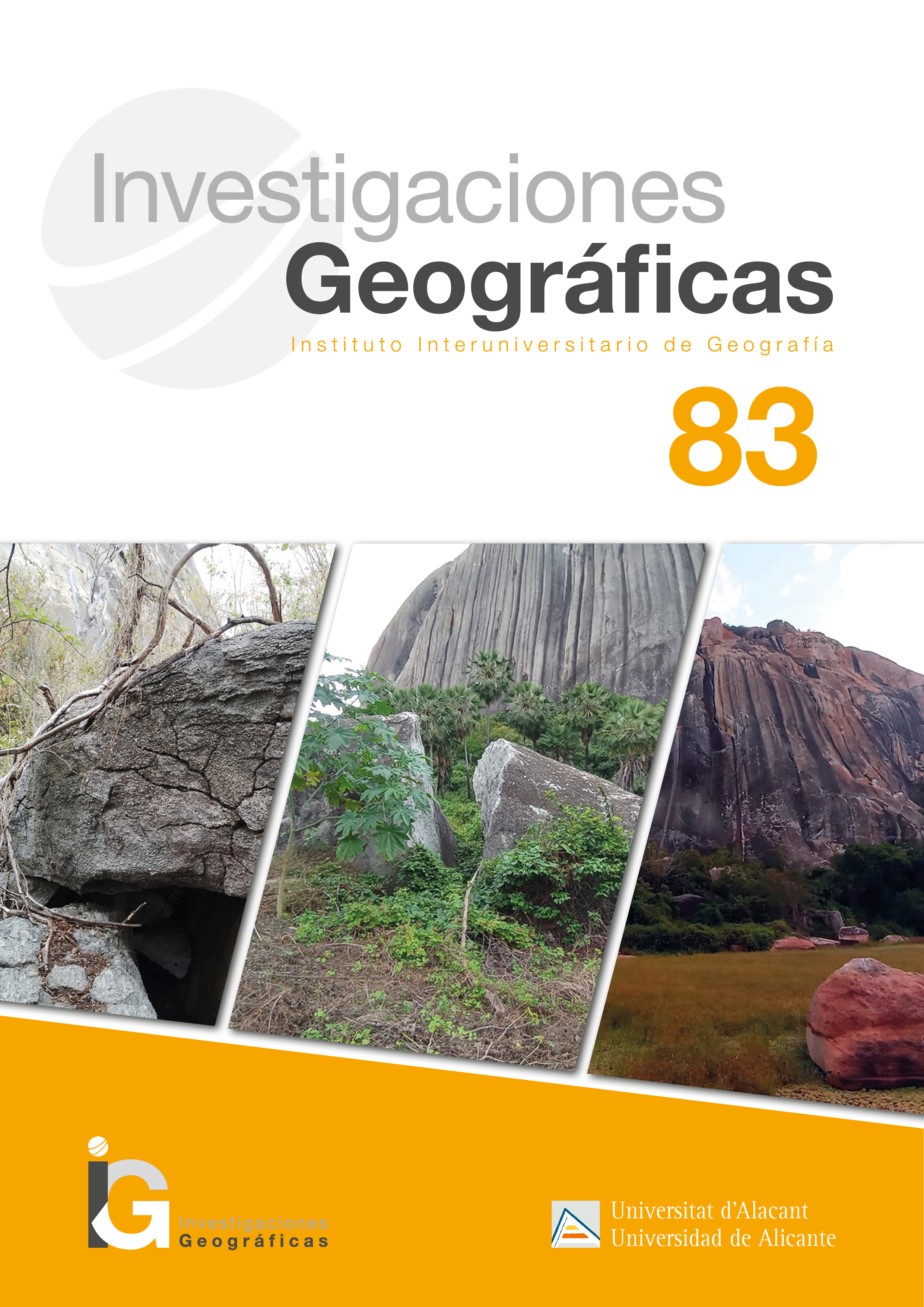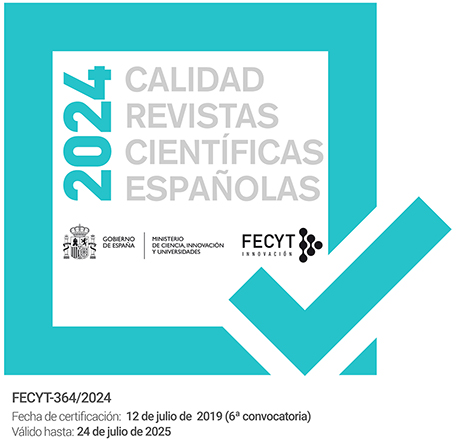Clasificación del relieve granítico del territorio del Proyecto Geoparque Sertão Monumental, Brasil
DOI:
https://doi.org/10.14198/INGEO.27310Palabras clave:
taxonomía geomorfológica, etchplanación, formaciones graníticas, inselberg, geoparque, nordeste brasileñoResumen
El relieve granítico se destaca en el paisaje del nordeste brasileño por su resistencia a los procesos geomorfológicos. En el territorio del Proyecto Geoparque Sertão Monumental, que abarca los municipios cearenses de Quixadá y Quixeramobim, hay una presencia significativa de rasgos graníticos, con diferentes formas y tamaños que muestran procesos subsuperficiales y superficiales. La Teoría del Grabado y los estudios morfodinámicos permitieron analizar el desarrollo de estas formas, lo cual se realizó mediante revisión de literatura, trabajo de campo y registros fotográficos. Los rasgos se clasificaron en macroformas y microformas, teniendo en cuenta sus características y origen. Las macroformas incluyen inselgebirg, inselberg, losas y afloramientos verticales. Las microformas se subdividieron en características asociadas con la meteorización, la saprolitización y la fractura. Esta clasificación y jerarquización contribuye a futuras investigaciones y estudios sobre el tema del relieve granítico.
Citas
Bastos, F. H., Lima, D. L. S., Cordeiro, A. M. N., & Maia, R. P. (2022). Granitic relieves of the brazilian northeast: a taxonomic proposal. In Carvalho Junior et al. (Org.), Brazilian geomorphology literature reviews (pp. 733-758). Universidade de Brasília. https://doi.org/10.26512/9786586503852.c26
Büdel, J. (1957). Die ‘doppelten Einebnungsflächen’ in den feuchten Tropen, Zeitschrift für Geomorphologie, 1(2), 223-225.
Büdel, J. (1982). Climatic Geomorphology. Princeton University Press.
Claudino-Sales, V. (2020). Potentialities of geodiversity: monoliths of Quixadá. In Cycle of Lectures: Know to AMMAr and Preserve. https://www.youtube.com/watch?v=s6TR7ITr0oA
Davis, W. M. (1899). The Geographical Cycle. The Geographical Journal, 4, 441-504. https://doi.org/10.2307/1774538
Dresch, J. (1957). Pediments et glacis d’érosion, pediplains et inselbergs. Information Géographique, 21(5), 183-196. https://doi.org/10.3406/ingeo.1957.1748
Goudie, A. S. (2004). Encyclopedia of Geomorphology (vol. 1). Routlegde.
Instituto Brasileiro de Geografia e Estatística (IBGE). (2023). Área territorial brasileira 2022.
King, L. (1966). The origin of bornhardts. Zeitschrift für Geomorphologie, 10, 97-98.
King, L. (1977). The Morphology of the Earth. Oliver & Boyd.
Lima, D. L. S. & Bastos, F. H. (2018). Geomorfologia em Granito – estudo das feições graníticas no Maciço de Uruburetama, Brasil. Anais do XII Sinageo. https://www.sinageo.org.br/2018/trabalhos/3/3-121-1982.html
Maia, R. P., Bezerra, F. H. R., & Nascimento, M. A. L. (2015). Geomorphology of the Quixadá Inselbergues Field, Northeast Of Brazil. Revista Brasileira de Geomorfologia, 16(2). https://rbgeomorfologia.org.br/rbg/article/view/651
Maia, R. P., Bastos, F. H., Nascimento, M. A. L., Lima, D. L. S., & Cordeiro, A. M. N. (2018). Granitic landscapes of the Northeast. UFC Editions.
Maia, R. P., Bastos, F. H., & Waldherr, F. R., do Nascimento, M. A. L., & Auler, A. S. (2022). Brief considerations on tafoni in inselbergs: genetic and morphostructural aspects. Revista Brasileira de Geomorfologia, 23(4), 1792-1811. https://doi.org/10.20502/rbg.v16i2.651
Maia, R. P. & Nascimento, M. A. L. (2018). Granitic Reliefs of Northeastern Brazil. Brazilian Journal of Geomorphology, 19(2). https://rbgeomorfologia.org.br/rbg/article/view/1295
Matmon, A., Mushkin, Y., Enzel, T., Grodek, K., & Aster, T. (2013). Erosion of a granite inselberg, Gross Spitzkoppe, Namib Desert. Geomorphology, 201, 52-59. https://doi.org/10.1016/j.geomorph.2013.06.005
Migón, P. (2006). Granitic Landscapes of the World. OUP Oxford. https://doi.org/10.1093/oso/9780199273683.001.0001
Migón, P. (2021). Granite Landscapes, Geodiversity and Geoheritage—Global Context. Heritage, 4(1), 198-219. https://doi.org/10.3390/heritage4010012
Olímpio, J. L. S., Monteiro, F. A. D., Freitas, L. C. B., Almeida, L. T., Alcantara, A. P., Loureiro, C. V., Nascimento, M. L., & Maia, R. P. (2021). What do we know about the inselbergs of Quixadá and Quixeramobim, Northeast Brazil? William Morris Davis - Journal of Geomorphology, 2(1), 1-24. https://williammorrisdavis.uvanet.br/index.php/revistageomorfologia/article/download/107/89/233
Pineo, T. R. G., Palheta, E. S. M., Costa, F. G., Vasconcelos, A. M., Gomes, I. P., Gomes, F. E. M., Bessa, M. D. M. R., Lima, A. F., Holanda, J. L. R., & Freire, D. P. C. (2020). Projeto Geologia e Recursos Minerais do Estado do Ceará. Escala 1:500.000. Ed. CPRM.
Peulvast, J-P. & Claudino-Sales, V. (2005). Surfaces d’aplanissement et géodynamique.Geomorphologie- relief, processus, environment, 11(4), 249-274. https://doi.org/10.4000/geomorphologie.605
Peulvast, J. P., & Vanney, J. R. (2001). Géomorphologie Structurale – Terre, Corps Planétaires Solids : Relief et Structure. BRGM.
Rocha, H. S., Maia, R. P., & Oliveira, V. P. V. (2019). Geomorphological heritage of the Pedra da Andorinha Conservation Unit, Sobral - Ceará. Revista GeoUECE, 8(14), 276-293.
Rodrigues, J. M. D., Lima, E. C., & Claudino-Sales, V. (2022). Hierarchical classification of granitic landforms in the Pedra Andorinha Wildlife Refuge Conservation Unit (REVIS), Taperuaba, Sobral, CE. Revista Brasileira de Geografia Física, 15(1), 140-153. https://doi.org/10.26848/rbgf.v15.1.p142-154
Romer, W. (2007). Differential weathering and erosion in an inselberg landscape in southern Zimbabwe: A morphometric study and some notes on factors influencing the long-term development of inselbergs. Geomorphology, 86, 349-368. https://doi.org/10.1016/j.geomorph.2006.09.008
Salgado, A. A. R. (2007). Plateau surfaces: old paradigms revised from the perspective of new geomorphological knowledge. Revista Geografias, 3(1), 64-78. https://doi.org/10.35699/2237-549X..13218
Souza, A. S. V., Maia, R. P. M., Bezerra, F. H. R., Migon, P., & Siame, L. L. (2023). Granitic inselberg erosion controlled by dike swarm array in semiarid Brazil. Geomophrology, 440, 108865. https://doi.org/10.1016/j.geomorph.2023.108865
Thomas, M. F. (1989) The role of etch processes in landform development I. Etching concepts and their applications. Zeitschrift für Geomorphologie Supplementary Issues, 33(2), 129–142. https://doi.org/10.1127/zfg/33/1989/129
Twidale, C. R. (2002). The two-stage concept of landform and landscape development involving etching: origin, development and implications of an idea. Earth Science Reviews, 57, 37-74. https://doi.org/10.1016/S0012-8252(01)00059-9
United Nations Educational, Scientific and Cultural Organization (UNESCO). (2024). UNESCO Global Geoparks. https://www.unesco.org/en/iggp/geoparks/about
Vidal-Romani, J. R. & Twidale, C. R. (2005). Landforms and Geology of Granite Terrains. Balkema.
Vidal-Romaní, J. R., Vaqueiro, M., & Sanjurjo, J. (2014). Granitic landforms in Galicia. In Gutiérrez, F., Gutiérrez, M. (Eds), Landscapes and Landforms of Spain. World Geomorphological Landscapes. Springer. https://doi.org/10.1007/978-94-017-8628-7_4
Vitte, A. C. (2001). Considerations on the theory of etchplanation and its application to studies of landforms in hot and humid tropical regions. Terra Livre, 16, 11-24.
Vitte, A. C. (2005). Dynamic and episodic terraforming in the hot and humid tropics. Revista do Departamento de Geografia, 16, 105-118.
Waldherr, F. R., Silva, T. M., & Ximenes, C. L., de Araújo-Júnior, H. I., & de Oliveira Rodrigues, S. W. (2022). Geomorphological aspects of the Jirau 01 fossiliferous natural pond, municipality of Itapipoca, state of Ceará, Brazil. Revista Brasileira de Geomorfologia, 23(2), 1317-1333. http://dx.doi.org/10.20502/rbg.v23i2.2039
Wayland, E. J. (1933). Peneplains and some erosional landforms. Geological Survey of Uganda, Annual Report and Bulletin, 1, 77-79. https://doi.org/10.20502/rbg.v23i2.2039
Descargas
Estadísticas
Publicado
Cómo citar
Número
Sección
Licencia
Derechos de autor 2025 Alexandre Pinheiro Alcântara, Vanda Claudino-Sales, João Luis Sampaio Olímpio, Adriano Luís Heck Simon, Rubson Pinheiro Maia

Esta obra está bajo una licencia internacional Creative Commons Atribución-NoComercial-CompartirIgual 4.0.
Los autores/as que publican en Investigaciones Geográficas están de acuerdo en los siguientes términos:
- Derechos de autor: La autoría conserva los derechos sobre sus trabajos, aunque cede de forma no exclusiva los derechos de explotación (reproducción, edición, distribución, comunicación pública y exhibición) a la revista. Los autores/as son, por tanto, libres de hacer acuerdos contractuales adicionales independientes para la distribución no exclusiva de la versión de la obra publicada en la revista (por ejemplo, alojarlo en un repositorio institucional o publicarlo en un libro), siempre que medie un reconocimiento de su publicación inicial en esta revista.
- Manifiesto: Los autores aseguran que Investigaciones Geográficas es el primer medio que publica su obra y garantizan que mientras se encuentra en fase de valoración y posible publicación en nuestra revista no se ha enviado, ni enviará a otros medios.
- Licencia: Los trabajos se publican bajo una licencia Creative Commons de Atribución-NoComercial-CompartirIgual 4.0 Internacional, salvo que se indique lo contrario. Esto es que se puede compartir y adaptar el material siempre que no se use con fines comerciales, se distribuya bajo la misma licencia del original, se realice atribución a la autoría y al primer medio que publica y se proporcione un enlace a la licencia. Igualmente hay que indicar si se han realizado cambios.

- Política de autoarchivo: Se permite y alienta a los autores/as a difundir electrónicamente el artículo final publicado (versión del editor) en Investigaciones Geográficas (como en repositorios institucionales, en su página web, ...) con el fin de lograr intercambios productivos y conseguir que la obra logre mayor citación (véase The Effect of Open Access, en inglés).






